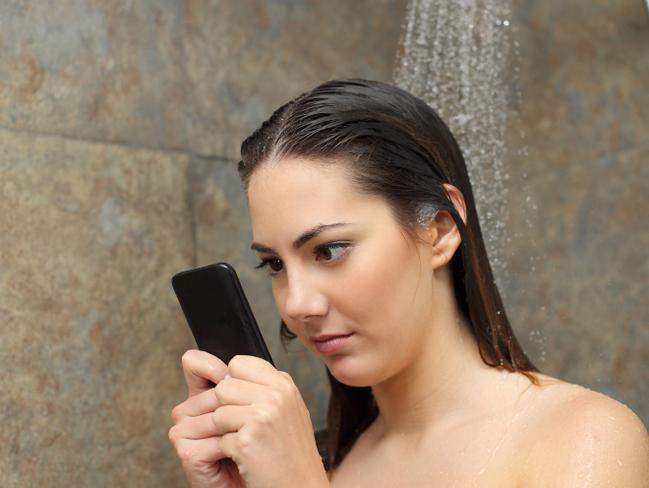The iPhone’s 10th birthday highlights how much our behaviour has changed in the smartphone era
THE iPhone turned 10 this week. The very first iPhone looked very different from the sleek devices we have in our pockets now.
THIS week marked the 10th anniversary since the public launch of arguably Apple’s most revolutionary product: the iPhone.
Naturally, it’s been a milestone that has prompted celebration and fond remembrance from technophiles and Apple fans around the world.
“Here’s to the #iPhone that changed the world, to the man who dreamed it & the people at Apple who have never stopped looking to its future,” tweeted Apple boss Tim Cook alongside a photo of the original device.
But while tech publications were all taking a nostalgic trip down memory lane, London professor André Spicer took a far dimmer view of the smartphone decade ushered in by the advent of the iPhone.
Writing for The Guardian, under the proactive headline “The iPhone is the crack cocaine of technology. Don’t celebrate its birthday” he mused about the dark side of the device and the prevalence of smartphone addiction in the modern world.
“One in three adults admits to checking their phone in the middle of the night; 12 per cent admit to using their phone while taking a shower; and 9 per cent say they check their smartphone during sex,” the professor of organisational behaviour wrote.
He recounted a story of attending a meeting with top European banking executives where they had to lockup their phones. He watched as they became visibly agitated and recalled the palpable relief when they were able to once again scroll through their emails.
“It was like watching crack addicts getting their first hit of the day,” he said.

The article went on to point out the well documented pitfalls of constant smartphone use such as its association with sleeping problems and an increased level of anxiety and depression. All of which led him to wonder “has this magical little device done more harm than good?”.
Of course, the iPhone isn’t responsible for smartphone addiction but even Steve Jobs was weary of just how addictive such devices could become.
After all it was the Apple co-founder who in a 2010 interview when asked if his kids loved the iPad said: “Actually we don’t allow the iPad in the home. We think it’s too dangerous for them in effect.”
It’s almost hard to remember a time before smartphone were constantly within arm’s reach and likewise it’s easy to forget just how much our behaviour has changed — and Australians are among the most addicted.
According to data collected by Melbourne software company Bugbean, Australian men unlock their phones more than anyone in the world — on average 45 to 46 times a day. For Australian women it’s around 42 times.
Adam Alter is the author of Irresistible: Why We Can’t Stop Checking, Scrolling, Clicking and Watching. Speaking to the ABC’s Lateline program last month, he said around 50 per cent of the adult population has some form of behavioural addiction — and smartphones are an obvious vice.
A growing number of people “feel that their lives are being encroached upon by devices, their social lives, maybe their relationships with their loved ones and friends. They’re not experiencing nature. They’re not exercising,” he said.
When Jobs walked on stage in 2007 to unveil the iPhone to the world, it was undeniably a monumental moment in consumer tech.
But I guess the point is, to celebrate the iPhone’s birthday, maybe put it down and go for a walk.
A look back at the decade of the iPhone https://t.co/YtWWJKDG6M #iPhoneAt10 pic.twitter.com/JcCJMNypv9
— Bloomberg Technology (@technology) June 29, 2017
HOW THE IPHONE HAS CHANGED IN 10 YEARS
As the world eagerly awaits for the forthcoming release of the iPhone 8, due out later this year, here’s how the popular device has evolved over the past decade.
NO APP STORE
The App Store, home to every addictive game and service a user could need did not appear until 2008, so adding and customising features to the phone was not an option. In fact, the original iPhone offered just 15 pre-installed apps, including the calculator, stocks, maps and weather apps.
TOUCHSCREEN
Until the iPhone, physical keyboards had been present on all of the biggest sellers in the mobile phone market. The iPhone was the first to successfully make the switch to multi-touch screens and virtual keyboards, eliminating the stylus at the same time, which had been popular on other touchscreen and PDA devices up to this point.
A SINGLE CAMERA
Selfies were yet to take off, but even if they had, taking one on an original iPhone would have proved difficult as it didn’t have a front-facing camera. Even the rear camera was only two megapixels, in comparison, the iPhone 7 houses a seven megapixel front-facing camera.
SOCIAL MEDIA
With no social media apps available, updating your Facebook or Twitter would involve using the web browser — which at this stage was still known only as Web and not Safari.
iPOD
In a nod to its previous great product success, the app we now know as Music was called iPod on the first iPhone. Indeed, Jobs even referred to the original iPhone as a phone combined with an iPod when announcing the device, rather than a smartphone.
-With AP



